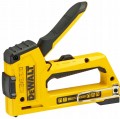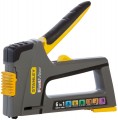Spring
The main structural element of the construction stapler. The spring first compresses, accumulating mechanical energy, and then decompresses, releasing it to clog the fastener. According to the type of springs are divided into two subcategories:
— Vitaya. The impact mechanism with a twisted (torsion) spring is cocked and then released when the lever is pressed. The force with which the bracket will be clogged is regulated using a special screw, if it is provided for in the design. The working resource of a twisted spring averages 10-12K strokes, after which the recoil becomes stronger and it is no longer so comfortable to work with the tool.
— Plate. In staplers with a leaf spring, a flat spring located horizontally is responsible for the tension of the striker. Usually, this type of springs is used in professional tools — they have a long service life (about 55 – 60K strokes), which allows the use of construction staplers for large-scale work.
Compatible staples
Staple models that the tool is compatible with.
Usually, quite specific options are indicated in this paragraph, so finding compatible consumables is not difficult. The specific dimensions of the fasteners should be specified according to the manufacturer's data — different brands use different markings.
Operation type
The actuation method provided in the design of the nail/stapler.
-
Contact. This option assumes that direct contact with the material being processed is necessary for operation. Usually, a movable working tip (“nose”) is used for this: until the tool is pressed against the material and the nose is not retracted to the stop, the mechanism will not work. This way of actuation has a positive effect on both efficiency and safety of work: tight contact ensures that the fastener will be hammered as reliably as possible, and the risk that the hammer will “shoot” with a staple or nail in the air is reduced to almost zero. However the need to press the tool tightly every time reduces the speed of work: although pressing takes a fraction of a second, however, on tens and even more hundreds of clogged fasteners, this moment becomes noticeable. On the other hand, many tools provide the ability to hold the trigger so that the stapler automatically fires each time the spout is pressed. But the unequivocal disadvantage of this option can be called the fact that the presence of a safety contact mechanism complicates and increases the cost of the tool.
-
Non -contact. Mechanisms that work regardless of whether the tool is pressed against the material or not. Other things being equal, the non-contact method of operation is faster than the contact one, because. does not require additional "body movements" du
...ring work. And the tool itself is lighter and cheaper. On the other hand, non-contact triggering requires increased care from the user: if handled carelessly, the tool can trigger at a certain distance from the surface of the material (which impairs clogging efficiency), or even “shoot” in an undesirable direction, which is fraught with material damage and even serious injury .Fuse
A device that protects the tool from being triggered at the wrong time.
Most often in a modern tool there are manual fuses in the form of a button or switch. Such a device blocks the release button or opens the power circuit; thus, when the
fuse is on, the tool will not work, no matter what the user does. This reduces the chance of fasteners "shooting" in the wrong direction and reduces the risk of personal injury and property damage.
Min. staple width
The smallest staple width that the stapler can handle.
The width of the bracket is, roughly speaking, the distance between its legs. Different situations and types of work require different sizes of staples, sometimes quite small. At the same time, staples that are too small will hang out in the store and will not be able to properly fit under the drummer, which is why modern staplers have a minimum size limit. You should pay special attention to it if you plan to work with brackets of small width.
Max. staple width
The largest width of staples (see Fastener Type) that the stapler can work with.
The width of the bracket is, roughly speaking, the distance between its legs. Different situations and types of work require different sizes of staples, and sometimes the width must be quite large. However, a staple that is too large simply will not fit into the store, not to mention the fact that the stapler can “shoot” it normally. Therefore, this limit cannot be exceeded, and if you plan to work with brackets, you should pay special attention to the maximum width when choosing.
Min. nail diameter
The smallest thickness of nails (see "Type of fastener") that the stapler can work with.
A nail that is too thin is just as undesirable for a tool as one that is too thick: already in the store, such parts can hang out, and there is no question of correct “shooting” at all. Therefore, this limitation should definitely be taken into account when choosing, especially if you plan to work with nails of small thickness. The most "thin" modern staplers have a minimum limit of about 1 mm, and in professional models it can exceed 2.5 mm and even 3 mm.
Max. nail diameter
The largest thickness of nails (see "Type of fastener") that the stapler can work with.
Thick nails require not only the appropriate size of the magazine and feeder, but also significant effort is required to drive them. Therefore, the larger the maximum allowable nail diameter, the more powerful, heavier and more expensive the tool, usually. Professional pneumatic nailers can be compatible with fasteners of 3.5 mm or more, but for entry-level tools, a thickness of 1.2 — 1.5 mm is often more than enough.
Min. nail length
The shortest length of nails (see Fastener Type) that the stapler can handle.
The shorter the fastener, with the same thickness, the less effort is required to drive it, but a nail that is too short simply cannot stand under impact normally. Therefore, for many instruments, this restriction is directly indicated. It is worth paying attention to it first of all if you plan to work with small short nails.

